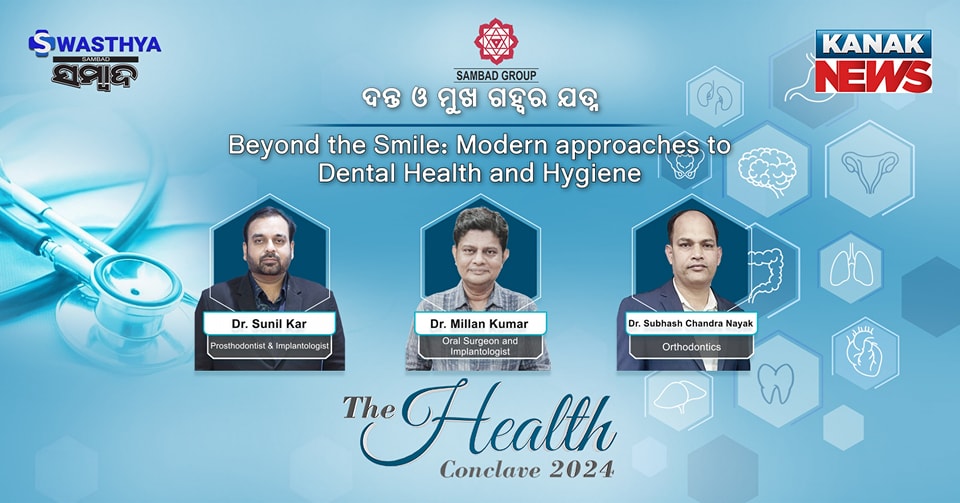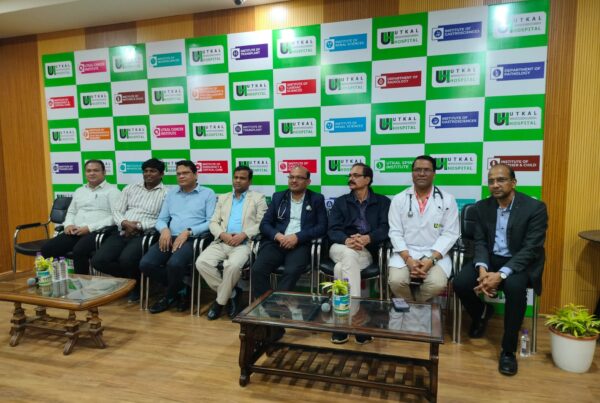Modern approaches to dental health and hygiene have evolved significantly with advancements in technology, better understanding of oral health, and increased awareness of the connection between oral and overall health. These approaches focus on prevention, early detection, innovative treatments, and personalized care.
In The Health Conclave’s last session, Dr Sunil Kar, Dr Milan Kumar and Dr Subhash Chandra Nayak discussed on dentistry beyond the smile. Here are the key details of the discussion.
1. Prevention and Early Detection
a. Personalized Preventive Care
- Genetic Testing: Advances in genetics allow for personalized dental care based on an individual’s genetic predisposition to oral health issues. For example, genetic testing can identify susceptibility to periodontal disease, tooth decay, or enamel erosion, allowing for customized preventive measures.
- Risk Assessment Tools: Modern dental practices use sophisticated risk assessment tools that evaluate an individual’s likelihood of developing dental problems such as cavities, gum disease, or oral cancer. This helps create a tailored prevention plan, including customized brushing, flossing, and dietary recommendations.
b. Fluoride and Antimicrobial Treatments
- Fluoride Varnishes and Gels: Topical fluoride treatments, like fluoride varnishes and gels, are now more effective and convenient for patients, offering stronger protection against tooth decay, especially for children and those with high cavity risk.
- Antimicrobial Mouth Rinses and Toothpastes: Antibacterial agents in mouth rinses (e.g., chlorhexidine) and toothpaste can help reduce plaque buildup, combat gingivitis, and prevent gum disease. New formulations are more effective and less irritating to the mouth than older versions.
c. Digital and AI-driven Diagnostics
- AI in Diagnostics: Artificial intelligence is increasingly being used to analyze dental x-rays, identifying early signs of cavities, tooth fractures, and other dental issues that might be missed by human clinicians. AI software can also help detect the early stages of oral cancer through analysis of images of the mouth and throat.
- Teledentistry: Telehealth services have expanded to include dental consultations through virtual platforms, allowing for remote diagnosis, follow-up care, and monitoring of dental conditions. This is particularly helpful for those with limited access to dental care.
2. Technological Advancements in Treatment
a. Laser Dentistry
- Minimally Invasive Laser Procedures: Laser technology is being increasingly used in dental procedures for its precision and minimal invasiveness. Lasers are used for cavity treatment, gum disease therapy (such as laser-assisted new attachment procedure, LANAP), teeth whitening, and even oral surgery. Benefits include faster healing times, reduced discomfort, and less risk of infection.
b. 3D Imaging and Digital Impressions
- Cone Beam CT Scans: Cone beam computed tomography (CBCT) provides a 3D view of the patient’s oral and maxillofacial structures, helping dentists plan complex procedures like dental implants with greater accuracy. This technology allows for better diagnosis, surgical planning, and follow-up care.
- Digital Impressions: Traditional molds used for crowns, bridges, and dentures are now being replaced by digital scanning. This technique is quicker, more comfortable for patients, and more accurate, leading to better-fitting restorations and a more efficient process.
c. Artificial Intelligence (AI) in Treatment Planning
- AI-driven Orthodontics: AI is increasingly integrated into orthodontics for planning treatments, creating more precise and efficient dental alignments. Smart aligners and AI-based software track a patient’s progress and adjust treatment plans in real time.
- Predictive Analytics for Treatment Success: AI models can predict the outcomes of various dental procedures, helping dentists make more informed decisions. This can optimize treatments like implants, extractions, and cosmetic dentistry procedures.
d. Dental Implants
- Minimally Invasive Implants: With advancements in implant technology, dental implants have become less invasive and more predictable. New techniques, such as flapless implants and immediate loading implants, allow for faster healing and improved patient satisfaction.
- All-on-4 Implants: This technique involves placing just four implants in the jaw to support a full set of replacement teeth. It offers a quicker, more cost-effective solution for people who need full-mouth restoration, with fewer implants and shorter recovery times.
3. Cosmetic Dentistry and Smile Design
a. Teeth Whitening
- Advanced Whitening Techniques: Modern teeth whitening treatments use bleaching agents that are more effective and safer than older methods. At-home whitening products with custom trays or professional in-office whitening procedures provide faster and longer-lasting results.
- Whitening with Less Sensitivity: New formulations are reducing tooth sensitivity during and after whitening procedures. This is especially important for patients with sensitive teeth who wish to brighten their smiles.
b. Veneers and Bonding
- Porcelain Veneers: These thin, custom-made shells are applied to the front surface of teeth to correct imperfections such as chips, stains, or misalignment. Advancements in materials and techniques make veneers more durable, natural-looking, and accessible for a broader range of patients.
- Composite Bonding: Composite bonding, which uses tooth-colored resin to fill cavities or reshape teeth, has improved in quality and versatility. It is a non-invasive and cost-effective alternative to crowns or veneers.
c. Orthodontics
- Clear Aligners: Clear aligner systems, such as Invisalign, have revolutionized orthodontic treatment. These nearly invisible aligners are an attractive alternative to traditional metal braces, with the added benefits of removability for eating and brushing.
- Accelerated Orthodontics: Techniques like AcceleDent and Propel use vibrations or micro-pulses to stimulate bone growth, potentially speeding up the movement of teeth during orthodontic treatment by 30–50%.
4. Improved Oral Hygiene Products
a. Smart Toothbrushes
- Electric and Sonic Toothbrushes: Modern electric toothbrushes, particularly those with sonic technology, are more effective at removing plaque and preventing gum disease. Many now feature pressure sensors to avoid excessive brushing that can damage gums, as well as built-in timers to ensure proper brushing duration.
- Connected Toothbrushes: Some electric toothbrushes now connect to apps via Bluetooth, providing real-time feedback on brushing habits, offering suggestions for improvement, and even tracking progress over time.
b. Mouth Care Innovations
- Antibacterial and Probiotic Toothpastes: Probiotic toothpaste, which contains beneficial bacteria, can help balance oral microbiota and reduce harmful bacteria that cause gum disease. This is an emerging trend in both preventing and treating conditions like gingivitis and halitosis.
- Whitening Toothpastes with Safe Ingredients: New whitening formulas use gentler ingredients, such as activated charcoal or baking soda, to whiten teeth without damaging enamel.
c. Flossing and Irrigation
- Water Flossers: Water flossers, like those from Waterpik, use a pulsating stream of water to clean between teeth and along the gum line, offering a more comfortable and effective alternative to traditional string floss.
- Interdental Brushes: These small, cylindrical brushes are becoming a popular choice for cleaning between teeth. They can be more effective than traditional floss, especially for patients with braces or larger interdental spaces.
5. Holistic and Integrative Approaches
a. Oral-Systemic Health Connection
- Connection to Overall Health: There is a growing awareness of the link between oral health and systemic conditions like heart disease, diabetes, and stroke. Modern dental care emphasizes treating the whole body, addressing how oral diseases can impact overall health.
- Natural and Alternative Treatments: Some patients are exploring natural treatments such as oil pulling (using coconut or sesame oil to cleanse the mouth), herbal remedies, and fluoride-free toothpaste. While not all natural alternatives are scientifically proven, there is increasing interest in integrating these approaches with conventional dental care.
6. Education and Patient Engagement
- Digital Education Tools: Interactive apps and websites allow patients to better understand their oral health, track habits, and receive personalized reminders for brushing, flossing, and appointments.
- Increased Awareness: Social media, dental blogs, and online videos have made dental care more accessible. Patients are becoming more educated about oral hygiene, treatment options, and the importance of maintaining good oral health from an early age.
Modern approaches to dental health and hygiene are characterized by precision, personalization, and technological advancements. These innovations in prevention, treatment, and oral care products are transforming the dental field and enabling patients to maintain better oral health with less effort and discomfort. With a growing focus on holistic and preventive care, patients can expect even more improvements in dental health and hygiene in the future.




